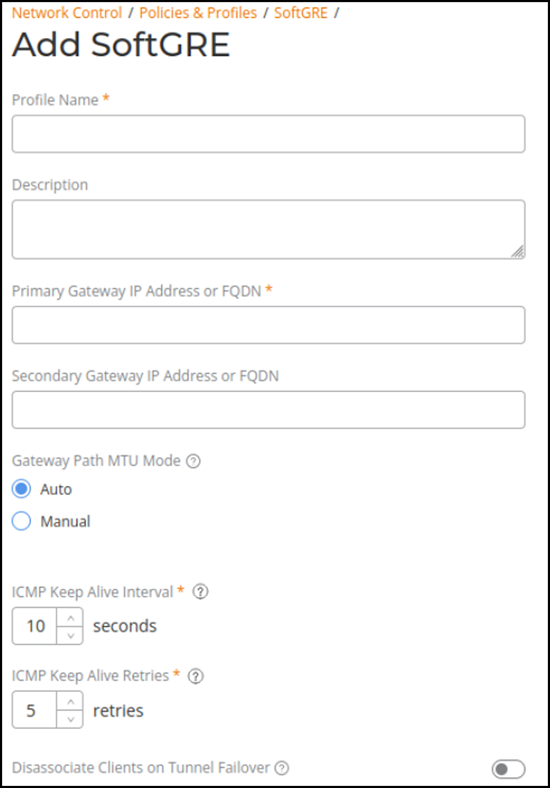Creating a SoftGRE Profile
You can configure a SoftGRE tunnel profile that, when applied at the network level for a venue, directs all encapsulated data traffic to a third-party, centralized gateway.
-
On the RUCKUS One web interface, navigate to Network
Control > Service
Catalog.
The Service Catalog page is displayed.
- Select SoftGRE.
-
Click Add.
The Add SoftGRE page is displayed.
Adding a SoftGRE Profile 
- Profile Name: Enter a name for the profile ranging from 2 through 32 characters. Each SoftGRE profile name must be unique.
- Description: (Optional) Enter a description for the SoftGRE profile.
- Primary Gateway IP Address or FQDN: Enter the IP address or fully qualified domain name (FQDN) of the primary gateway server.
- Secondary Gateway IP Address or FQDN: (Optional) Enter the IP address or fully qualified domain name (FQDN) of the secondary gateway server. Both the Primary and Secondary Gateway addresses must be different within a single SoftGRE profile.
-
Fallback to Primary Gateway: (Optional) Toggle this
setting to on to allow APs to automatically switch back from the secondary to
the primary gateway when it becomes reachable. By default, this setting is
disabled.
When enabled, the Primary Availability Check Interval setting becomes available. Enter the time interval from 60 (default) through 1440 minutes that defines how often the AP checks if the primary SoftGRE gateway is reachable.
-
Gateway Path MTU:
Set the maximum transmission unit (MTU) for the gateway path.
Select one of the following options:
- Auto: This is the default option.
- Manual: The transmission range is from 850 through 9018 bytes. You can configure the MTU value by using the get mtu eth{PORT_NUMBER} command.
Note:Check Ethernet MTU on the AP as the Tunnel MTU gets applied only if it is lesser than Ethernet MTU value.
- ICMP Keep Alive Interval: Enter the time interval in seconds. The time interval refers to how often APs send a keep-alive message to the active third-party WLAN gateway. The range is 1 to 180 seconds, and the default value of 10 seconds.
- ICMP Keep Alive Retries: Enter the number of keep-alive attempts. Keep-alive attempts refer to the number of times APs wait for a response from the active third-party WLAN gateway before failing over to the standby gateway. The range is 2 to 10 attempts, and the default is 5 attempts.
- Disassociate Clients on Tunnel Failover: Enable this option to disassociate the client when the AP fails over to another tunnel.
- Click Add.